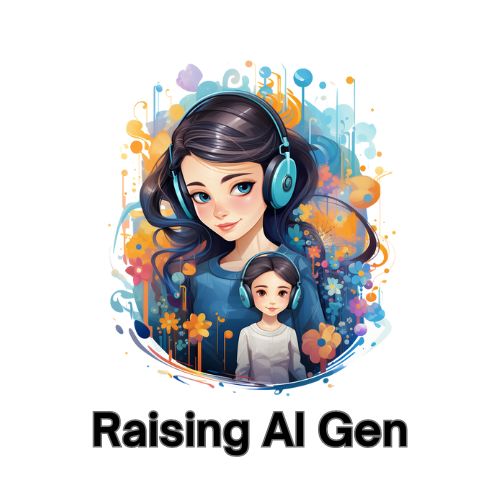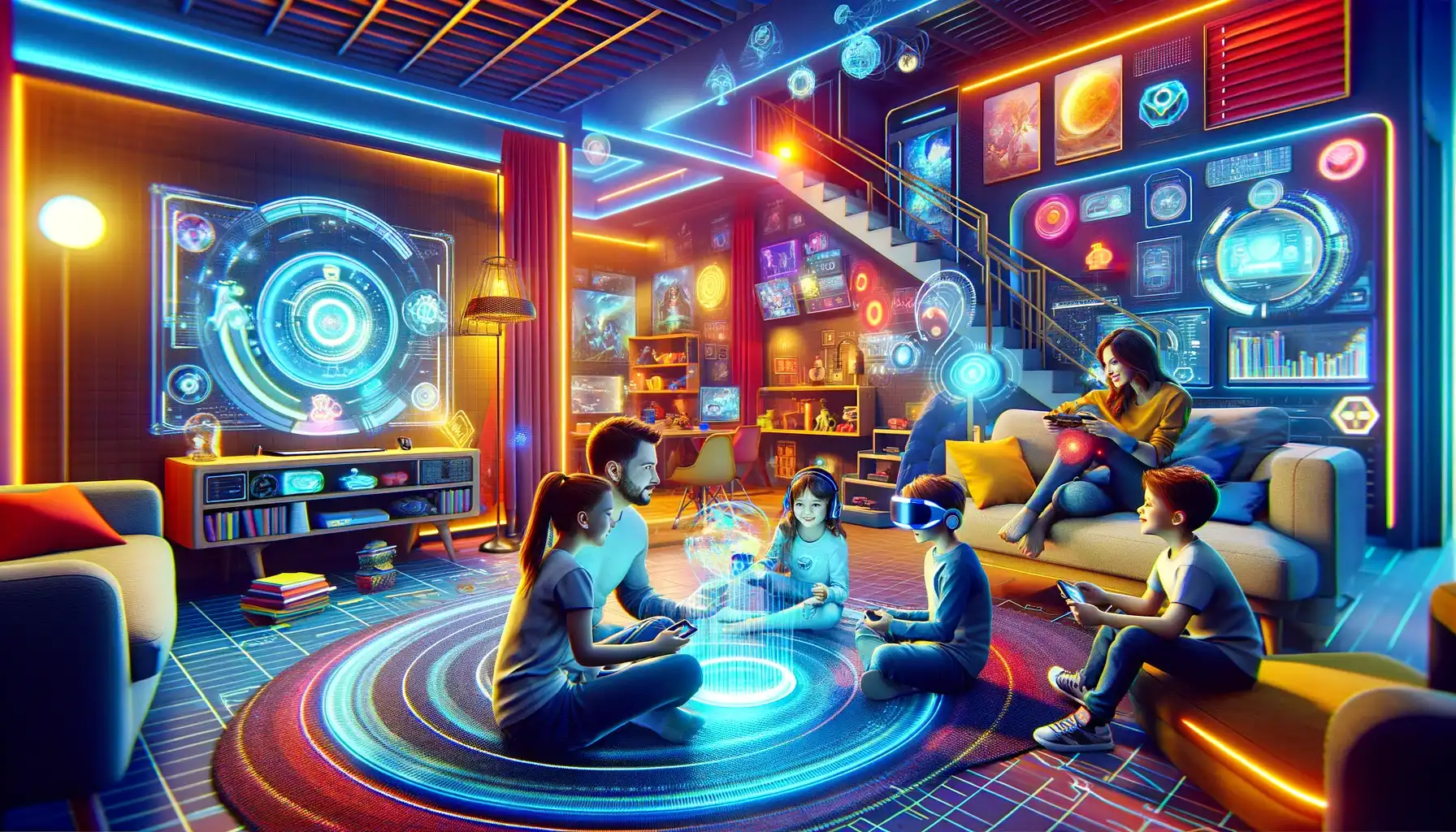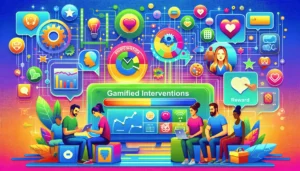The realm of family fun is undergoing a transformation, propelled by the rapid advancements in artificial intelligence (AI). No longer confined to the silver screen, AI in entertainment has transcended into our living rooms, offering family-friendly technology that brings forth an era of smart playtime. Artificial intelligence has embedded itself in toys for kids, creating companions that are responsive, engaging, and tailored to enrich the playtime experience like never before.
In an age where screens often dominate entertainment, AI-powered toys are crafting new avenues for children to learn, grow, and interact. These technological advances are not just tickling the fancy of the tech-savvy but are redefining family fun for all. As parents and educators seek out the best in smart toys for kids, the industry responds with innovations that blend the charm of traditional play with the clever prowess of AI companions.
Key Takeaways
- AI is making waves in the field of family entertainment, introducing a novel dimension to children’s playtime activities.
- Family-friendly technology is leveraging AI to create smart toys that are interactive and adaptable to each child’s learning pace and style.
- Artificial intelligence playtime is shaping the future of play with toys becoming companions that assist in social and cognitive child development.
- Smart toys for kids now come with a personalized touch, thanks to AI’s ability to learn and react to emotional and educational cues.
- Technological advances in family fun are blending the best of analog play with cutting-edge digital interactions for a holistic entertainment experience.
The Advent of AI Toys and Their Impact on Children’s Play
As the digital landscape evolves, AI-based toys are becoming increasingly prominent, reshaping the way children play and interact. These intelligent toys stand at the forefront of an entertainment paradigm shift, offering youngsters unique opportunities to engage with interactive robot friends that promise to bolster their social and cognitive development. With names like Miko, Roybi, Moxie, and Zivko, these AI play companions go far beyond the static play patterns of the past.
Introduction to AI-based Play: Miko, Roybi, Moxie, and Zivko
In this new era, toys are no longer inert objects; they have transformed into interactive playtime tools that listen, learn, and grow alongside children. Taking the shape of cute robots or animated critters, AI toys like Miko and Roybi are revolutionizing interaction, beckoning a future where interactive educational experiences are the norm in every playroom.
Adaptive Play: Beyond Pre-Programmed Responses
What sets these smart educational toys apart is their remarkable capability for adaptive learning. Unlike their predecessors, these toys utilize behavioral AI to dynamically adjust their behavior and teaching methods according to the child’s responses, mood, and individual learning curve, ensuring a truly personalized companion that’s both fun and educational.
Emotional Intelligence and Learning Through Play
On the journey to fostering well-rounded development, toys like Moxie are not just fun; they are emotional intelligence toys designed to nurture sensitivity, understanding, and mindfulness—qualities that are essential for children’s social development. By engaging them in meaningful dialogues and responsive interactions, these AI learning robots help children navigate the complex landscape of emotions.
The Significance of Social Relationships in AI Toys
The advent of AI has paved the way for AI-assisted social interactions unlike any before. These toys play a critical role in the development of AI companionship, creating a new narrative in the way children build and understand relationships. However, they also raise important questions about the ethical implications of AI toys on young, impressionable minds. As these toys develop the ability to emulate human interactions, they wield the power to heavily influence the social fabric of future generations.

In this digital revolution, it is essential to critically assess the potential impact and purpose of AI in play. The interplay of cutting-edge technology with the timeless joy of childhood play prompts a thorough examination of these novel interactions and their long-term implications for children’s social development. As we traverse this new era of play, it is imperative to embrace the benefits of these innovations while remaining vigilant about their appropriate use and potential challenges.
The Crossroads of AI and Family Entertainment
At the intersection of technology and togetherness, a revolution is taking place: AI-enhanced play is steadily becoming a cornerstone of technology in family activities. Where once board games and outdoor pursuits were the go-to for family gaming, we’re now witnessing a seamless fusion of AI’s innovative touch with the nostalgic essence of shared moments.
From voice-activated games that recommend new family adventures to smart home entertainment systems that transform living spaces into interactive playgrounds, AI is reshaping family time as we know it. The ramifications of these changes ripple beyond mere fun, with implications for family bonds and social skills development that are just beginning to be understood.
AI-enhanced play is not without its fair share of intricacies. While the opportunities to create personalized play experiences are unprecedented, they also beckon us to ponder how this technology fits within the fabric of family life. Privacy concerns, the grip of screen time, and the fairness of access are threads weaving a complex web of considerations in this brave new world of play.
The following table illustrates some of the core points of consideration as families navigate this era of expansive technological possibilities:
| Consideration | Opportunity | Challenge |
|---|---|---|
| Personalized Game Recommendations | Spurs interest with tailored fun | Maintaining balance with spontaneous play |
| Privacy in Game Settings | Customization to family preferences | Ensuring data security and privacy |
| Screen vs. Physical Interaction | Enhanced teaching with technology | Preserving human touch in learning |
| Equality of Technology Access | Equalizing opportunities for development | Addressing socio-economic disparities |
In a society that increasingly values both technological fluency and healthy personal relationships, AI-enhanced play represents both a frontier and a tightrope. To honor the heritage of family connection while ushering in the enchantment of AI, industry creators and family members alike must walk this path with care, creativity, and an eye on the collective horizon.
As we probe the balance between automation and intimacy, we find ourselves at a pivotal juncture in history. This moment calls for a nurturing approach to family gaming. It beckons us to steer the ship with attention not just to where we are headed, but to whom we are taking along for the ride—our children, families, and the very fabric of society that will be sculpted by today’s choices in smart home entertainment.
Enhancing Traditional Games with AI Technology
The wave of the board game renaissance is swelling as technology bridges the gap between the tactile warmth of tabletop games and the infinite possibilities of the digital world. Traditional games, once confined to flat boards and physical play pieces, are experiencing a digital reinvention that is breathing dynamic new life into a beloved pastime.
The Digital Reinvention of Board Games
In an extraordinary blend of the old and new, digital board games are captivating players with their innovative design, bringing about a fresh wave of excitement. Fusing classic strategies with technology-integrated board games, these modern iterations extend play beyond the table, launching us into a realm of immersive gameplay. The infusion of digital components ensures that every dice roll and card draw is part of a transformed, enchanting game narrative.
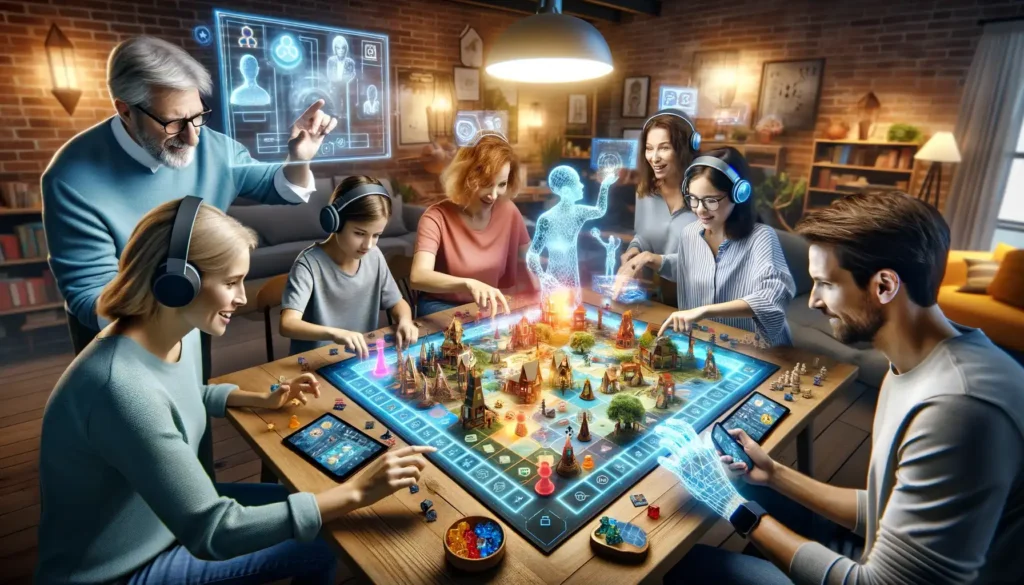
Interactive Features and Augmented Reality in Play
Heightening player involvement, AR in board games unlocks a visual spectacle that once belonged solely to the imagination. Through the lens of augmented reality, players interact with games on a level that accentuates both engagement and delight, offering an enhanced play experience that rivals traditional expectations. This confluence of sight and touch introduces a tactile subtlety to the digital board gaming world.
Cultivating Online Communities Through Gaming
From the comfort of their homes, players are now able to access global gaming communities, creating connectivity in gaming like never before. These shared gaming experiences allow fans to forge friendships over vast distances, exchange strategies, and celebrate victories in a spirited digital fellowship, profoundly enriching the gaming culture.
The Contribution of Mobile Apps to Gaming Convenience
As an apex of modern gaming’s convenience, board game companion apps have revolutionized the way we set up, learn, and engage with board games. These innovative gaming apps offer rulebooks, tutorials, and supplementary content that serve to streamline the board gaming process, facilitating a seamless transition from learning to gameplay.
| Technology | Contribution to Board Games | Impact on Player Experience |
|---|---|---|
| Interactive Components | Bringing pieces and dice to life with electronic versatility | Increases immersion and interaction |
| Augmented Reality (AR) | Adding visual elements to physically static games | Creates a multidimensional and enriched gameplay environment |
| Global Online Platforms | Connecting players through digital networks | Builds communities and enhances global interaction |
| Mobile Apps | Offering digital assistance and solo play options | Provides convenience and extends playability |
As we wade deeper into the 21st century, the infusion of AI and digital technology into the world of board games is a testament to the versatility and enduring appeal of this form of entertainment. Whether it’s through augmented reality, mobile apps, or online communities, technology has not only revived the classic board game but has elevated it to a level of inclusiveness and innovation never before seen.
AI’s Role in Fostering Educational and Social Development
The integration of AI for social skills into the fabric of children’s educational experiences is not just groundbreaking; it’s reshaping the landscape of learning. Educational AI companions, like the Moxie robot produced by Embodied Inc., have entered the play realm, merging child development with AI in unprecedented ways.
The importance of social-emotional AI robots in children’s lives is increasingly recognized, bridging the digital to personal gap by cultivating human-like interactions that enrich both cognitive skills development and social competencies. These AI learning aids have begun to address essential aspects of personal growth through thoughtfully programmed engagement, setting a new standard for what educational play can look like.
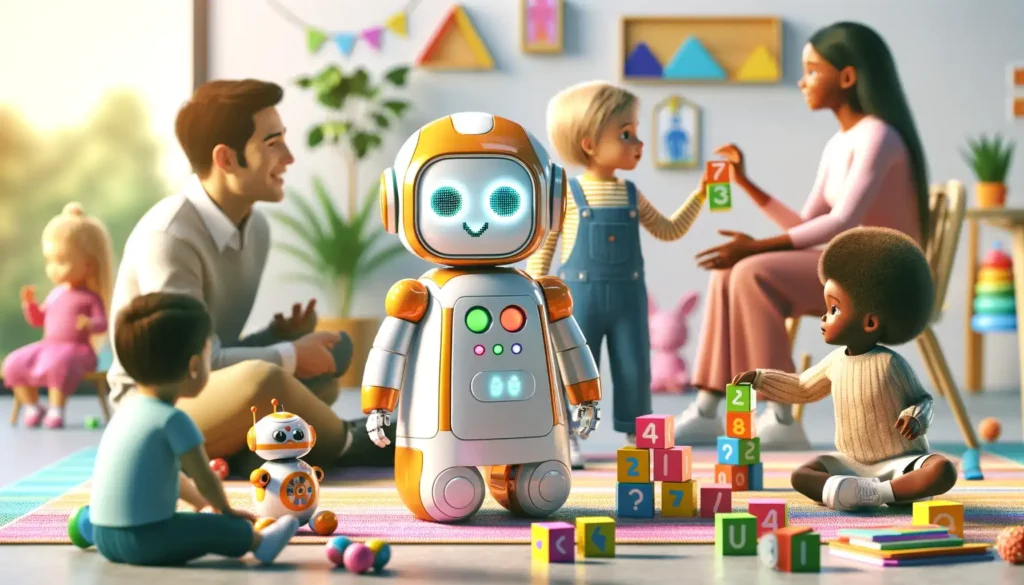
Social-Emotional Learning with AI Companions
Social-emotional learning (SEL) has become a pivotal part of the educational discourse, and AI companions are at the front lines of this evolution. Through interaction and dialogue, AI companions assist with emotional regulation, encourage mindfulness, and foster a spirit of kindness amongst children. As a result, there is a marked improvement in children’s social skills and emotional awareness—a cornerstone for their path to well-rounded maturity.
AI as a Tool for Cognitive and Educational Enrichment
The notion that playtime is distinct from learning is rapidly dissolving as AI becomes a powerful agent of cognitive and educational enrichment. AI-driven toys challenge children’s problem-solving skills and stimulate critical thinking, transforming play into an opportunity for dynamic learning and intellectual engagement.
Moxie Robot: A Case Study in Enhancing Child Development
Moxie, designed with the intent to serve children with developmental challenges, stands tall as a case study in applying AI research in child development. Moxie’s interactiveness is rooted in AI’s ability to offer personalized support and foster cognitive growth, tailoring its responses and activities to the unique preferences and needs of each child.
A study of Moxie robot benefits reveals a significant positive impact on children’s social skills and emotional intelligence. To facilitate a balanced use, a phone app allows insight for parents into their child’s engagement with Moxie, ensuring tech-time is educational, safe, and moderated.
| Feature | Description | Impact on Child Development |
|---|---|---|
| Personalized Interactions | Moxie’s AI customizes experiences based on the child’s behavior and preferences. | Enhances learning and promotes emotional intelligence. |
| Parental Monitoring App | App that allows parents to track and manage their child’s activities with Moxie. | Provides parental oversight to balance technology usage with other developmental activities. |
| Social-Emotional Exercises | Activities focused on developing empathy, kindness, and self-regulation. | Improves social skills and aids in emotional development. |
| Adaptive Learning | AI that adjusts its teaching style to the child’s learning pace. | Encourages cognitive growth in a stress-free environment. |
In the journey of leveraging AI research in child development, Moxie and its contemporaries are not just tools but partners. Through interactive stories, educational tasks, and emotional intelligence exercises, they lay a foundation that propels children towards a future where AI is more than just a passing trend—it is an integral part of their personal development journey.
Challenges and Ethical Considerations in AI-Powered Play
The intersection of artificial intelligence and children’s entertainment carries with it distinct considerations for a future governed as much by lines of code as by lines of children’s laughter. As we incorporate smart technology into playtime, issues concerning AI affordability, technology accessibility, and socio-economic barriers come sharply into focus, begging a thorough analysis of not only the benefits but also the possible implications for equity, ethical interaction, and cultural influence.
While AI toys like Moxie are celebrated for their innovative contributions to child development, these technological marvels may inadvertently deepen the divide between those who can and cannot access such tools, creating a stark rift influenced by socio-economic status. This new dichotomy in playtime accessibility raises questions about the social implications of AI toys and whether all children can partake in these groundbreaking experiences.
The Digital Divide and Access to AI Entertainment
As AI-enhanced play becomes more prevalent, the digital divide sharpens, spotlighting the chasm separating families with the means to afford advanced toys from those left on the other side of the technology accessibility threshold. While we marvel at AI’s ability to tailor educational content to the individual child, we must ask ourselves who gets to benefit from these tailor-made experiences and ponder the ever-widening gap of digital inequity.
Addressing Potential Bias in AI Interactions
Another pressing concern is AI bias and how these preconceptions, encoded within complex algorithms, could permeate through cultural representations in AI. It is incumbent upon creators to design AI toys that uphold algorithmic fairness, ensuring that all children see themselves reflected without prejudice, stereotype, or marginalization, and that the AI interactions they engage with are as inclusive and diverse as the world in which they live.
Cultural Impacts and Behavioral Influence of AI Toys
Ultimately, the reach of AI toys extends beyond individual learning, impacting broader societal norms and potentially shaping behavior through AI. The influence exerted by AI companions can redefine traditional play and relationship norms, underscoring the importance of responsible design and thoughtful dialogue surrounding AI’s cultural influence and the long-term ramifications of such intimate technological interactions during childhood.
| Ethical Aspects | Considerations | |
|---|---|---|
| Access and Affordability | Representation and Fairness | |
| AI Affordability | Ensuring cost does not prevent access to learning and growth opportunities. | N/A |
| Technology Accessibility | Creating inclusive design that allows all children to engage with AI play. | N/A |
| Socio-economic Barriers | Identifying support structures to bridge gaps in technology adoption. | N/A |
| AI Bias | N/A | Mitigating data-driven prejudices to foster a diverse AI landscape. |
| Cultural Representations in AI | N/A | Ensuring AI toys serve as mirrors and windows of a multicultural world. |
| Algorithmic Fairness | N/A | Achieving impartiality in AI decision-making and interactions. |
In the quest to harness AI’s potential to enchant and educate, we must concurrently address the complexities it introduces to our social framework. Only then can we ensure that AI-powered play becomes a conduit for growth, fairness, and unity, rather than an unwitting instrument of division and bias.
Prospective Changes and Innovations in AI-Enhanced Entertainment
As we stand on the brink of technological evolution, AI-enhanced entertainment is charting a course toward a future rich with innovation. The forecast for playtime teems with advancements that seek not only to amaze but also to foster deeper and more meaningful connections through virtual experiences. Key players in this revolution include Virtual Reality (VR) and Augmented Reality (AR), IoT devices, and blockchain applications, all converging to create a landscape where play becomes more than just a game—it becomes a portal to new worlds and possibilities.
The Future of Virtual and Augmented Reality in Play
The pursuit of the future of immersive play is spearheaded by VR and AR technologies, transcending traditional gaming methods and delivering captivating realms for players to explore. With VR headsets and AR applications, the lines between the physical and virtual blur, offering an unparalleled sensory adventure. As these platforms mature, children and adults alike will revel in gaming environments that respond to their movements and decisions in real-time, framing a new narrative in the realm of interactive entertainment.
Emerging Trends: AI, IoT, and Blockchain in Games
In the ever-shifting world of AI games, the promise of connectedness brought forth by the Internet of Things (IoT) hints at a future where toys and games are not only aware but are continually adapting and evolving. This network of smart devices will leverage AI trends to offer a customized play experience like never before. Simultaneously, blockchain gaming stands to revolutionize ownership and economy within interactive entertainment, providing a secure and transparent framework for digital transactions and assets.
Anticipating the Impact of AI Companions on Future Generations
As the guardians of a new dawn, today’s children are forming AI relationships that will shape societal interactions for years to come. The intricacies of these AI companionship ethics need to be proactively reviewed to understand the long-term effects of AI on emotional and social development. It is our collective responsibility to ensure that the integration of AI into children’s lives is conducted with care, preserving the wonder of childhood while preparing for a future where technology is a steadfast ally.
Frequently Asked Questions
| Question | Answer |
|---|---|
| Why is AI important in entertainment? | AI is crucial in entertainment for its ability to personalize content, enhance interactivity, and create new forms of media. It enables more engaging, immersive experiences and supports the development of innovative games, movies, and interactive platforms tailored to diverse audiences. |
| How will AI affect family life? | AI is poised to have a significant impact on family life by providing enhanced educational and entertainment tools, creating new ways for families to interact with technology, and offering personalized experiences. It can streamline everyday tasks and bring novel forms of family-oriented leisure activities. |
| What are the disadvantages of AI in entertainment? | The disadvantages include potential job displacement in creative sectors, over-reliance on technology, privacy concerns, and the risk of diminishing human creativity. AI-driven content might also lead to homogenization of entertainment, where diverse and unique artistic expressions could be underrepresented. |
| What is an example of a positive impact that AI has on entertainment? | A positive impact of AI in entertainment is its ability to create adaptive learning games for children, which not only entertain but also educate. AI-driven games can adjust their difficulty based on the player’s skill level, making them both fun and educational tools for family engagement. |
Further Reading
| Title | Link |
|---|---|
| AI for Organizing Family Health Records | Read More |
| How is AI Used in Mental Health | Read More |
| Is There an AI for Mental Health | Read More |
| AI in Education Books | Read More |
| AI Personalized Learning | Read More |
| AI Speech Therapy | Read More |
| AI for Educators | Read More |
| AI Tools for Teachers | Read More |
| AI for Language Learning | Read More |
